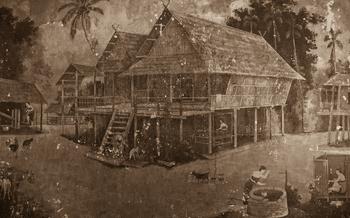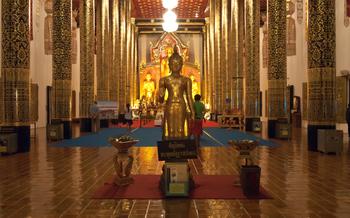
Wat Phra That Lampang Luang
- The Founding Legend of the Temple
- Religious Significance
- Cultural and Artistic Value
- Things to See and Do
- Surrounding Attractions
- Photography and Videography
- Accommodation and Dining Options
- Transportation and Getting There
- Historical Anecdotes and Legends
- Conservation and Restoration Efforts
- Local Festivals and Events
- Insider Tip:
The Founding Legend of the Temple
The founding legend of Wat Phra That Lampang Luang is deeply rooted in local folklore and religious beliefs. According to legend, the temple's origins date back to the 13th century when a revered monk named Phraya Maha Muni travelled from Sukhothai to Lampang. Guided by a miraculous dream, he discovered a sacred relic of the Buddha, a fragment of his collarbone, hidden beneath an ant mound.
The discovery of this holy relic sparked great excitement and devotion among the local people. Phraya Maha Muni, inspired by divine guidance, initiated the construction of a grand stupa to enshrine the precious relic. The stupa, known as Phra That Lampang Luang, became the focal point of religious devotion and a symbol of the city's spiritual heritage.
Religious Significance
The Wat Phra That Lampang Luang holds immense religious significance in Theravada Buddhism. It is considered a sacred pilgrimage site, attracting devout Buddhists from near and far. Pilgrims visit the temple to pay homage to the Phra That Lampang Luang, which is believed to enshrine a relic of the Buddha. The temple complex serves as a center for religious ceremonies, rituals, and festivals. Monks residing at the temple lead daily prayers, meditation sessions, and dharma talks, providing spiritual guidance and teachings to the local community. The temple also plays a crucial role in preserving and promoting Buddhist traditions and values, fostering a deep sense of spirituality and devotion among its followers.
Cultural and Artistic Value
Wat Phra That Lampang Luang holds immense cultural and artistic significance, showcasing the unique Lanna-style architecture and motifs. The temple's design incorporates intricate details and symbolism, reflecting the fusion of Buddhist and local traditions. Visitors can admire the stunning murals adorning the temple walls, depicting scenes from the Buddha's life and Jataka tales. These murals are not only visually captivating but also serve as a source of religious and cultural education. Sculptures and other forms of artwork found within the temple further enhance its artistic value, providing a glimpse into the creative expressions of Lanna artisans. The temple's preservation of local traditions and heritage makes it a living museum, where visitors can experience the vibrant culture and rich history of Northern Thailand.
Things to See and Do
- Explore the temple's grounds. Marvel at the intricate architecture and serene ambiance. Take your time to admire the chedi's grandeur, the viharns' delicate details, and the ordination hall's impressive structure.
- Pay homage to the Phra That Lampang Luang and make offerings. Show your respect by bowing and offering flowers, candles, or incense. Participate in merit-making rituals, a core part of Thai Buddhist culture.
- Visit the viharns and learn about the Buddha's teachings. Attend a meditation session or a dharma talk to deepen your understanding of Buddhism and gain inner peace.
- Attend a meditation session or a dharma talk. Find tranquility and spiritual guidance through meditation and listen to insightful teachings from resident monks.
Surrounding Attractions
Lampang offers a wealth of attractions beyond the Wat Phra That Lampang Luang. Explore the city's rich history at the Lampang National Museum, which houses artifacts from the region's past. Immerse yourself in the vibrant local culture at the Kad Kong Ta Street Market, where you can find everything from fresh produce to handmade crafts. For a taste of nature, head to the Chae Son National Park, home to stunning waterfalls, lush forests, and diverse wildlife. And don't miss the Elephant Conservation Center, where you can learn about these majestic creatures and witness their rehabilitation efforts.
Photography and Videography
When visiting Wat Phra That Lampang Luang, photography and videography are permitted, but certain guidelines must be followed to ensure respect for the sacred nature of the site.
- Respectful Photography:
- Always ask for permission before photographing or filming people, especially monks or individuals engaged in religious activities.
- Avoid using flash photography inside the temple's viharns or near sacred objects to prevent damage.
-
Be mindful of your surroundings and avoid disrupting ongoing ceremonies or rituals with your photography.
-
Capturing the Best Shots:
- Utilize natural light to capture the temple's architecture and surroundings in their best light.
- Experiment with different angles and perspectives to create unique and captivating shots.
-
Take advantage of the temple's serene atmosphere to create contemplative and meditative images.
-
Responsible Drone Usage:
- Flying drones within the temple complex is generally not permitted.
- If drone photography is permitted, ensure you have obtained the necessary authorization and follow all safety guidelines.
- Respect the privacy of others and avoid flying your drone over people or sensitive areas.
Accommodation and Dining Options
Lampang offers a range of accommodation options for visitors, from budget-friendly guesthouses to comfortable hotels. For a truly immersive experience, consider staying at a traditional Thai-style homestay, where you can interact with local families and learn about their way of life. Several local restaurants and eateries serve authentic Thai cuisine, including regional specialties like khao soi and sai oua. Vegetarian and vegan options are also available for those with dietary restrictions. To find the best food and dining experiences, venture off the beaten path and explore the local markets, where you can sample fresh produce, handmade snacks, and delicious street food.
Transportation and Getting There
Reaching Wat Phra That Lampang Luang is a breeze, with various transportation options available. If you're coming from major cities like Bangkok or Chiang Mai, convenient train and bus services will take you directly to Lampang. Once in Lampang, local transportation options like tuk-tuks and songthaews are readily available to whisk you to the temple's doorstep.
For a more independent adventure, consider renting a bicycle or motorbike to explore the city and its surroundings at your own pace. This option allows you to soak in the local vibes and discover hidden gems along the way. Guided tours are also available, providing a hassle-free way to learn about the temple's history and significance while immersing yourself in the local culture.
Historical Anecdotes and Legends
The founding of Wat Phra That Lampang Luang is shrouded in a captivating legend that has been passed down through generations. According to local folklore, a revered monk named Phra Ruang led a group of followers from Chiang Mai to establish a new temple in Lampang. As they journeyed, they encountered a miraculous sight: a radiant light emanating from a tree. Recognizing this as a divine sign, they decided to build the temple on that very spot.
Another tale associated with the temple revolves around a precious relic known as the "Phra Kaew Don Tao." Legend has it that this sacred Buddha image, carved from a single piece of green jade, was brought to Lampang from Sri Lanka by a group of merchants. Upon their arrival, the merchants presented the image to the local ruler, who enshrined it within the temple's chedi. The Phra Kaew Don Tao is believed to possess immense spiritual power and is revered by devotees from far and wide.
Over the centuries, Wat Phra That Lampang Luang has witnessed numerous historical events and played a significant role in the region's cultural and religious development. During the reign of King Ramkhamhaeng the Great, the temple underwent extensive renovations and became a prominent center of Theravada Buddhism in northern Thailand. It is said that the king himself visited the temple and made generous donations to support its upkeep.
Conservation and Restoration Efforts
The Wat Phra That Lampang Luang has undergone several restoration and conservation efforts throughout history to preserve its architectural integrity and religious significance. The temple's unique Lanna-style architecture and intricate artwork require specialized care and expertise to maintain their original splendor. Conservators and artisans work diligently to restore and repair damaged structures, murals, and sculptures using traditional techniques and materials.
One of the most significant challenges in preserving the temple is the natural aging process and the effects of weather and climate on its delicate structures. The temple's location in a tropical region exposes it to heavy rains, strong winds, and intense sunlight, which can cause deterioration over time. Conservators must carefully assess the condition of the temple's structures and develop appropriate conservation strategies to mitigate these effects.
Another challenge lies in balancing the need for preservation with the temple's ongoing use as a place of worship. While conservators strive to maintain the temple's historical authenticity, they must also ensure that it remains a functional and welcoming space for devotees and visitors. This requires careful consideration of the impact of conservation interventions on the temple's religious and cultural significance.
Despite these challenges, the conservation and restoration efforts at the Wat Phra That Lampang Luang have been successful in preserving the temple's heritage for future generations. The dedication and expertise of conservators and artisans have ensured that this sacred site continues to stand as a testament to the rich cultural and religious traditions of Thailand.
Local Festivals and Events
The Wat Phra That Lampang Luang is a hub of religious and cultural activities throughout the year, with several festivals and events that draw both local devotees and visitors from afar. One of the most significant events is the Lampang Temple Fair, held annually in March or April, coinciding with the Songkran festival. The fair features a colorful procession of floats, traditional performances, merit-making ceremonies, and a lively market selling local delicacies and handicrafts.
Another important festival is Visakha Bucha, which commemorates the Buddha's birth, enlightenment, and passing into Nirvana. During this time, the temple organizes special prayers, meditation sessions, and candlelight processions, creating a serene and spiritual atmosphere.
For those interested in experiencing the local culture, the Lanna Cultural Festival held in November or December is a must-attend. This vibrant festival showcases traditional Lanna music, dance, food, and handicrafts, providing a glimpse into the region's rich heritage.
Participating in these festivals and events is an excellent way to immerse oneself in the vibrant religious and cultural traditions of Lampang. Visitors are encouraged to join in the festivities, make offerings, and interact with the friendly locals to gain a deeper understanding of Thai Buddhism and the unique customs of the region.
Insider Tip:
The best time to visit Wat Phra That Lampang Luang is early in the morning or late in the afternoon when the sunlight beautifully illuminates the temple's architecture. The early morning hours are usually quieter, allowing you to explore the grounds and admire the intricate details without the crowds. As the day progresses, the temple complex becomes livelier as locals and tourists come to pay homage and make merit.
This tranquil atmosphere makes it an ideal time for reflection and meditation, allowing you to connect with the temple's spiritual essence. Moreover, the golden hues of the late afternoon sun cast a magical glow on the temple, creating a picturesque backdrop for capturing stunning photographs. By visiting during these times, you can fully immerse yourself in the temple's serene beauty and embrace its sacred ambiance.


